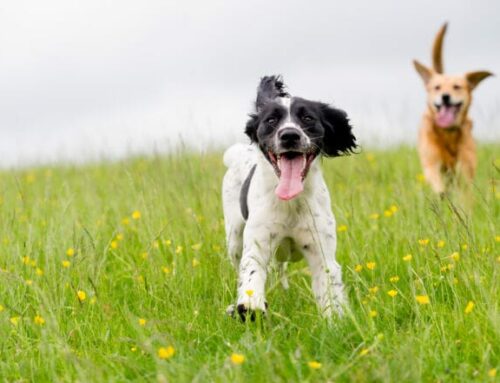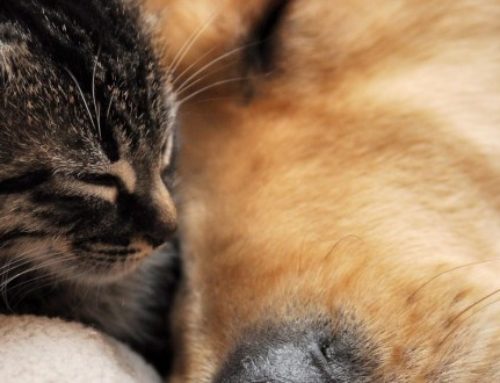Spay is the common word for ovariohysterectomy, which is the surgical removal of the uterus and ovaries, also referred to as neutering (the gender-neutral term). Many think the only reason for carrying out this procedure is to prevent unwanted babies. While it does do this, it also carries many health benefits. Here we will talk about these benefits, as well as dispelling some of the common urban myths around spaying. New studies are constantly being carried out on this topic, so veterinary advice is always based on the current evidence.
What does the surgery involve?
In dogs and rabbits in the UK, we perform the surgery through an incision on their tummy (midline). In cats, the incision is normally on their side (flank) but sometimes midline. The whole procedure usually takes about 30 minutes for a cat and an hour in a dog or rabbit, but can vary. Recovery time is around 10-14 days and your vet will dispense pain relief and advice to make sure your pet is comfortable postoperatively.
Why do it?
As well as increasing your pet’s lifespan there are many more specific reasons why it is beneficial.
In female dogs, spaying:
- Reduces the chance of breast cancer. Mammary tumours (MT) are the most common type of malignant tumour in female dogs and are more common in female unspayed dogs or those that were spayed after the age of 2. Half of mammary neoplasms are malignant. Dogs spayed before the first season have a 0.5% risk, dogs spayed after the first season have an 8% risk, and dogs spayed after the second oestrus have a 26% risk of developing mammary tumours, compared to being unneutered.
- Prevents the potentially life-threatening infection of the womb (pyometra). At 10 years old, the incidence rate of pyometra is 23%.
- Prevents a condition known as pseudopregnancy (false pregnancy) where dogs after a season suffer swollen mammary glands, produce milk and can have behaviour changes.
- Will not change your pet’s personality and may help reduce behavioural changes associated with coming into season. If you pet is having behavioural issues, there are likely to be other underlying causes. Speak to your vet for advice.
- Means she is less likely to direct amorous intentions towards visitors and cushions, and means less attention from male dogs.
- Stops pregnancies. Once pregnant you’ve got the responsibility of having to care for her during her pregnancy, birth, and looking after a litter that can be as large as 12 then finding them (good) homes. This can be stressful and costly.
- Prevents seasons which can be messy, often with 3 weeks or more of blood being produced.
- Prevents unwanted dogs, thousands of which are euthanised every year because there aren’t enough homes for them. You can help by neutering yours.
In female cats, spaying:
- At any age reduces the risk of mammary tumours by 40-60%. 85% of mammary tumours in cats are malignant and most are aggressive.
- Prevents pyometra.
- Prevents stress associated with trying to stop your cat getting pregnant. They come into season over and over again from February to September and can get desperate to go out. This attracts a lot of vocal, fighting males. A female cat can produce up to six kittens, three times a year. That’s a lot of mouths to feed and a lot of homes to find.
- Like with dogs, thousands of unwanted cats are put to sleep every year because there are not enough homes for them. You can help by getting your cat neutered.
In female rabbits, spaying:
- Prevents uterine cancer. Up to 80% of unneutered female rabbits develop uterine cancer by 5 years of age.
- May enable rabbits to live together. Unspayed rabbits are at risk of pregnancy and can be aggressive. Companionship is very important to rabbit wellbeing.
- Prevents a population explosion as rabbits are very good at breeding.
Are there any risks?
No surgery is without risks, but if your pet is healthy then the benefits outweigh the risks.
- Anaesthetic mortality rate in a healthy dog/cat is around 0.05-0.1%. Although rabbit anaesthesia has improved over the last few years, they still carry a higher risk of around 1-5%.
- One study showed spayed dogs as having an increased risk of cruciate rupture (a ligament of the knee) but more research is needed to confirm this.
- There is conflicting evidence about weight gain after spaying in dogs, however spaying is a less important risk than other factors such as diet and exercise.
- Some studies suggest an increased risk of some types of cancer, in some breeds of dog. However, even in spayed bitches the absolute risk is still much, much lower than the risk of pyometra or breast cancer, and not all studies have shown these risks to be significant.
- Studies show spaying increases the risk of urinary incontinence in susceptible dogs due to urethral sphincter mechanism incompetence (USMI), especially in large dogs. We do not fully understand why, but USMI is often successfully managed with medications.
When do I spay?
Conflicting evidence exists regarding the best time to spay your dog. There’s no evidence for any emotional or physical benefits of having a litter before spaying. Spaying before the first season greatly decreases the risk of mammary tumours, but exact timelines are still contentious. Using current evidence, neutering female dogs either before the first season, but not before four months of age, or in between the first and second season, seems sensible, although many vets will advise waiting a little longer in giant-breed dogs.
Cats become sexually active around 5 months of age, and can spayed from 16 weeks. Some vets advise to wait until 5-6 months, which is also okay.
Rabbits can be spayed from 16 weeks, and ideally when over 1kg.
Having worked in the charity sector for several years, operating on many dogs with preventable pyometras and mammary masses, if I had a female pet I’d not hesitate to spay her. Your local vet or vet nurse will be happy to discuss the benefits of neutering with you more fully.






